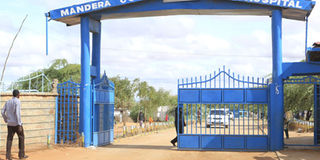540 admitted in Mandera following Chikungunya outbreak

Health officials in Mandera County have raised alarm after 540 residents were on May 25, 2016 reported to have been admitted in various hospitals following outbreak of Chikungunya disease. PHOTO | MANASE OTSIALO | NATION MEDIA GROUP
What you need to know:
- The Aedes mosquitoes that transmits chikungunya virus breed in a wide variety of rain-filled containers.
- Approximately 3pc–28pc of people infected with chikungunya will show no symptoms.
- For people who develop symptomatic illness, the incubation period is typically 3–7 days (range, 1–12 days).
- Disease is most often characterised by sudden onset of high fever (temperature typically 39°C) and joint pains.
At least 500 patients have been admitted following an outbreak of Chikungunya, a viral disease transmitted by infected mosquitoes, in Mandera County.
Mandera chief officer of health Mariam Dubow Dahir said the number of those infected with the mosquito-borne disease could rise as most schools were affected.
“The 540 are patients admitted in public hospitals. We have sent word to schools for head teachers to give the number of students that are infected and the figure could rise from tomorrow,” Ms Dubow told the Nation on Wednesday.
However, the Ministry of Health has scaled down the number saying that only 260 suspected cases whose blood samples had been taken to the Kenya Medical Research Institute (Kemri) have been reported.
According to Principal Secretary of Health Dr Nicholas Muraguri, the disease is under control as blood samples of those suspected to be infected have been taken to Kemri for confirmatory testing.
“The figures we have are lesser than what you are being told,” said Dr Muraguri.
He also said that the disease has only been detected in Mandera due to the proximity with neighbouring Somalia, which has been battling the disease.
“Most of these outbreaks we are having are consequences the heavy rainfall being experienced across the country,” said Dr Muraguri.
To contain the situation, the PS said that the ministry will roll out a vector control programme to spray all mosquito breeding areas.
“We have sent out Sh80 million worth of drugs and chlorinating chemicals to contain both problems,” added Dr Muraguri.
Part of the money, Sh50 million, Dr Muraguri explained, will be used to buy medication needed to contain the current cholera outbreak in the county.
Chikungunya is a viral disease transmitted to humans by infected Aedes species mosquitoes (A. aegypti and A. albopictus).
The daytime biting Aedes aegypti female mosquito (which bites mostly in the morning and late afternoon hours) is the same one that also spreads yellow fever, Dengue fever and Zika virus.
The most common symptoms of the disease are fever and joint pains. It also causes headache, muscle pain, joint swelling or rash.
While Dr Muraguri explained that the disease has no treatment, he said that the joint pains can be managed using painkillers.
“Most of the chikungunya cases we have are often taken care of as outpatient cases. It is not a serious disease,” he said.
In 2004, Kenya experienced two major outbreaks of chikungunya, the first outbreak in Lamu County, resulted in an estimated 13,500 cases, which represents more than 70 per cent of the population of the island.
The second outbreak occurred in Mombasa County a few months after the first cases in Lamu.
The outbreak started a four year period in which the virus spread throughout numerous islands of the Indian Ocean, India and parts of Southeast Asia.
According to the World Health Organisation (WHO) reports in 2014 the disease had infected more than two million people in the last decade, with Chikungunya infections at the time being estimated to be around 350,000.
CHOLERA OUTBREAK
The disease outbreak in Mandera comes at a time when health care workers are also struggling to contain cholera outbreak that has so far killed 11 people and left 734 others admitted.
Through an online write up, Amref Health Africa Chief Executive Dr Githinji Gitahi said: “The ongoing outbreak is exacerbating the cholera outbreak and affecting provision of health services in the county as some of the health workers have also been infected.”
To contain the situation and help put a stop to the spread of the epidemic, Dr Gitahi said the medical charity has launched an emergency appeal for Sh25 million.
“The sanitation situation in Mandera is critical, with erratic water supply and inadequate sanitation facilities. The town has no reliable water supply and currently relies on water tankers and donkey cart transporters,” he added.
ABOUT CHIKUNGUNYA
- Chikungunya is rarely fatal.
- The Aedes mosquitoes that transmits chikungunya virus breed in a wide variety of rain-filled containers.
- Approximately 3pc–28pc of people infected with chikungunya will show no symptoms.
- For people who develop symptomatic illness, the incubation period is typically 3–7 days (range, 1–12 days).
- Disease is most often characterised by sudden onset of high fever (temperature typically 39°C) and joint pains.
- Other symptoms may include headache, arthritis, conjunctivitis, nausea, vomiting or rash. Fevers typically last from several days up to 1 week.
- Symptoms are generally self-limiting and last for 2–3 days.
- The virus remains in the human system for 5-7 days and mosquitoes feeding on an infected person during this period can also become infected.
Source: WHO & CDC






